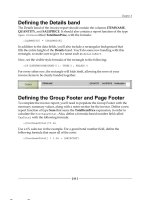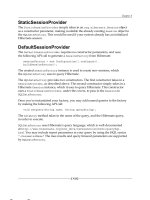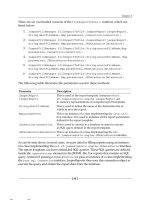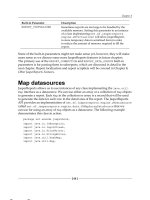Mastering phpMyAdmin 3.3.x for Effective MySQL Management pdf
Bạn đang xem bản rút gọn của tài liệu. Xem và tải ngay bản đầy đủ của tài liệu tại đây (16.93 MB, 412 trang )
www.it-ebooks.info
Mastering phpMyAdmin 3.3.x
for Effective MySQL Management
A complete guide to getting started with
phpMyAdmin 3.3 and mastering its features
Marc Delisle
BIRMINGHAM - MUMBAI
www.it-ebooks.info
Mastering phpMyAdmin 3.3.x
for Effective MySQL Management
Copyright © 2010 Packt Publishing
All rights reserved. No part of this book may be reproduced, stored in a retrieval
system, or transmitted in any form or by any means, without the prior written
permission of the publisher, except in the case of brief quotations embedded in
critical articles or reviews.
Every effort has been made in the preparation of this book to ensure the accuracy
of the information presented. However, the information contained in this book is
sold without warranty, either express or implied. Neither the author, nor Packt
Publishing, and its dealers and distributors will be held liable for any damages
caused or alleged to be caused directly or indirectly by this book.
Packt Publishing has endeavored to provide trademark information about all of the
companies and products mentioned in this book by the appropriate use of capitals.
However, Packt Publishing cannot guarantee the accuracy of this information.
First published: October 2010
Production Reference: 1041010
Published by Packt Publishing Ltd.
32 Lincoln Road
Olton
Birmingham, B27 6PA, UK.
ISBN 978-1-849513-54-8
www.packtpub.com
Cover Image by Marc Delisle ()
www.it-ebooks.info
Credits
Author
Marc Delisle
Reviewers
Michal Čihař
Ben Dodson
Kai 'Oswald' Seidler
Development Editor
Reshma Sundaresan
Technical Editor
Conrad Sardinha
Indexer
Hemangini Bari
Editorial Team Leader
Akshara Aware
Project Team Leader
Lata Basantani
Project Coordinator
Sneha Harkut
Proofreader
Dirk Manuel
Production Coordinator
Adline Swetha Jesuthas
Cover Work
Adline Swetha Jesuthas
www.it-ebooks.info
About the Author
Marc Delisle was awarded "MySQL Community Member of the year 2009"
because of his involvement with phpMyAdmin. He started to contribute to the
project in December 1998, when he developed the multi-language version. He is
still involved with phpMyAdmin as a developer and project administrator.
Marc is a system administrator at Cegep de Sherbrooke, Québec, Canada. He
has taught networking, security, and web application development. In one of his
classes, he was pleased to meet a phpMyAdmin user from Argentina. Marc lives in
Sherbrooke with his wife and they enjoy spending time with their four children.
This book was Marc's rst one and was quickly followed by Creating your
MySQL Database: Practical Design Tips and Techniques, also published by
Packt Publishing.
I am truly grateful to Louay Fatoohi who approached me for this
book project, and to the Packt team whose sound comments were
greatly appreciated during the production. My thanks also go to the
excellent reviewers Kai 'Oswald' Seidler, Ben Dodson, and Michal
Čihař. Their sharp eyes helped in making this book clearer and more
complete.
Finally, I wish to thank all contributors to phpMyAdmin's source
code, translations, and documentation; their dedication to this
project continues to push me forward.
www.it-ebooks.info
About the Reviewers
Michal Čihař was born in 1980 in Prague, the capital city of the Czech Republic,
and he is still living there. He studied Software Engineering at the Czech Technical
University, and during these studies he started contributing to several free software
projects, with the biggest contributions being made to phpMyAdmin and Gammu,
and related projects. He currently works for Novell, mostly on the SUSE Linux
Enterprise platform.
Michal has been active in the phpMyAdmin project since 2001, when he started as
a translator for the Czech language, later moving to a developer role (working, for
example, on index manipulation, and export and import subsystems), and since 2010
he has also acted as a secondary project manager.
Ben Dodson has worked with the Internet for over 15 years, yet originally studied
Politics. He trained briey as an Air Trafc Controller for the RAF before deciding
to change career paths and work as a freelance HTML/PHP developer, in Devon.
He relocated to London to work for a digital agency, and was rapidly promoted to
Development Manager in charge of a team of front- and back-end web developers in
several countries.
After working for a few more agencies, he decided to return to freelancing but this
time as an iPhone Developer. He now splits his time in Central London between
working on his own applications and working on applications for brand-name
clients, incorporating everything from store locators to iPad magazine concepts.
Ben still maintains a strong connection to his web development roots by working on
APIs for geo-coded Wikipedia Articles (
www.wikilocation.org) and the London
Underground (www.tubeupdates.com). One of his main interests is in the power of
location-aware applications and so he has spent a lot of time developing Gowalla
Tools, a suite of applications that utilize the popular Gowalla geo-location service.
www.it-ebooks.info
Aside from his websites and iPhone applications, Ben enjoys working on
everything from browser extensions to OpenID servers. He is a keen photographer
and designer, and is currently working on his rst book, which discusses
Machiavellian republicanism.
Ben has been invited to speak at several conferences and has appeared on BBC
Television's "Working Lunch" program to discuss e-commerce, and also Channel
Five's "The Gadget Show" to demonstrate iPhone Application development.
Kai 'Oswald' Seidler was born in Hamburg in 1970. He graduated from the
Technical University of Berlin with a Diplom Informatiker degree (Master of Science
equivalent) in Computer Science. In the '90s he created and managed Germany's
biggest IRCnet server, irc.fu-berlin.de, and co-managed one of the world's
largest anonymous FTP servers, ftp.cs.tu-berlin.de. He professionally set
up his rst public web server in 1993. From 1993 until 1998, he was a member of
Projektgruppe Kulturraum Internet, a research project on net culture and network
organization. In 2002, he co-founded Apache Friends and created the multi-platform
Apache web server bundle XAMPP. Around 2005, XAMPP became the most popular
Apache stack worldwide. In 2006, his third book, Das XAMPP-Handbuch, was
published by Addison Wesley.
Currently he's working as a technology evangelist for web tier products at Sun
Microsystems.
www.it-ebooks.info
www.it-ebooks.info
www.it-ebooks.info
To Carole, André, Corinne, Annie, and Guillaume, with all my love.
www.it-ebooks.info
www.it-ebooks.info
Table of Contents
Preface 1
Chapter 1: Getting Started with phpMyAdmin 7
Introducing phpMyAdmin 7
Web applications 7
PHP and MySQL: The leading open source duo 8
What is phpMyAdmin? 9
Project documentation 10
Installing phpMyAdmin 10
Required information 10
System requirements 11
Downloading the les 11
Installing on different platforms 12
Installing on a remote server using a Windows machine 12
Installing on a local Linux server 12
Installing on local Windows servers (Apache, IIS) 13
Conguring phpMyAdmin 13
The cong.inc.php le 13
Avoiding false error messages about permissions on cong.inc.php 14
Conguration principles 14
Web-based setup script 16
Manually creating cong.inc.php 22
Tips for editing cong.inc.php on a Windows client 23
Description of some conguration parameters 23
PmaAbsoluteUri 23
Server-specic sections 24
PersistentConnections 26
Upgrading phpMyAdmin 26
Summary 27
www.it-ebooks.info
Table of Contents
[ ii ]
Chapter 2: Conguring Authentication and Security 29
Logging in to MySQL through phpMyAdmin 29
Logging in to an account without a password 30
Authenticating a single user with cong 30
Testing the MySQL connection 31
Authenticating multiple users 31
Authentication types offered 31
The control user 32
Logging out 32
Authenticating with HTTP 33
Authenticating users with cookie values 33
Authenticating through the signon mode 35
Conguring for multiple server support 36
Dening servers in the conguration le 37
Authenticating through an arbitrary server 38
Securing phpMyAdmin 39
Protecting phpMyAdmin at the directory level 39
Displaying error messages 40
Protecting with IP-based access control 40
Dening rules 40
Order of interpretation for rules 41
Blocking root access 42
Protecting in-transit data 42
Authenticating using Swekey hardware 43
Conguring Swekey authentication 43
Using phpMyAdmin in a Swekey context 44
Security note 45
Access logging 45
Available information 45
Conguring Apache 46
Summary 46
Chapter 3: Over Viewing the Interface 47
Over viewing panels and windows 47
Login panels 47
Navigation and main panels 48
Home page 48
Views 48
Query window 49
Starting page 49
Customizing general settings 49
Conguring the window title 49
Conguring icons 50
Natural sort order for database and table names 50
Creating site-specic headers and footers 50
www.it-ebooks.info
Table of Contents
[ iii ]
Displaying MySQL documentation links 51
Themes 51
Conguring themes 52
Selecting themes 52
Assigning colors using the color picker 53
Sliders 54
Limiting URL lengths 54
Restricting the list of databases 54
Character sets, collations, and language 55
Collations 55
Unicode and UTF-8 56
Selecting languages 56
Effective character sets and collations 57
Navigation panel 58
Conguring the logo 59
Database and table list 59
Light mode 60
Full mode 62
Table short statistics 63
Table quick-access icon 63
Nested display of tables within a database 63
Choosing from the server list 65
Handling many databases or tables 66
Limits on the interface 66
Improving fetch speed 67
Main panel 68
Home page 68
Database view 69
Table view 71
Server view 72
Icons for the home page and menu tabs 72
Opening a new phpMyAdmin window 73
Query window 73
Summary 74
Chapter 4: Taking First Steps 75
Creating a database 75
No privileges? 76
First database creation is authorized 76
Creating our rst table 78
Choosing the elds 78
Creating a table 78
Choosing keys 80
www.it-ebooks.info
Table of Contents
[ iv ]
Inserting data manually 82
Data entry panel tuning for CHAR and VARCHAR 83
Browse mode 84
SQL query links 85
Navigation bar 86
Query results operations 88
Sorting results 89
Headwords 90
Color-marking rows 90
Limiting the length of each column 91
Display options 91
Browsing distinct values 92
Customizing the browse mode 93
Creating an additional table 93
Summary 95
Chapter 5: Changing Data and Structure 97
Changing data 97
Entering edit mode 97
Moving to the next eld with the tab key 99
Moving with arrows 99
Handling NULL values 99
Applying a function to a value 100
Duplicating rows of data 102
Multi-row editing 102
Editing the next row 103
Deleting data 104
Deleting a single row 104
Deleting many rows 105
Deleting all of the rows in a table 105
Deleting all rows in many tables 106
Deleting tables 106
Deleting databases 107
Changing a table's structure 107
Adding a eld 107
Vertical mode 109
Horizontal mode 109
Editing eld attributes 109
TEXT elds 110
BLOB (Binary Large Object) elds 111
Uploading binary content 112
ENUM and SET elds 114
DATE, DATETIME, and TIMESTAMP elds 116
Calendar pop up 116
www.it-ebooks.info
Table of Contents
[ v ]
TIMESTAMP options 118
Bit elds 118
Managing indexes 119
Single-eld indexes 119
Multi-eld indexes and index editing 120
FULLTEXT indexes 121
Optimizing indexes with EXPLAIN 122
Detecting index problems 124
Summary 124
Chapter 6: Exporting Structure and Data (Backup) 125
Dumps, backups, and exports 125
Scope of the export 126
Exporting a database 126
The export subpanel 128
SQL 128
Dening options for SQL export 128
The "Save as le" subpanel 133
File name template 133
Compression 134
Choosing a character set 134
Kanji support 135
CSV 136
CSV for MS Excel 137
PDF 137
Microsoft Word 2000 138
LaTeX 139
XML 140
Open document spreadsheet 141
Open document text 142
YAML 143
CodeGen 143
Texy! text 143
PHP array 144
Excel 97-2003 and Excel 2007 Workbook 144
MediaWiki table 145
Exporting a table 145
Split-le exports 146
Exporting selectively 146
Exporting partial query results 146
Exporting and checkboxes 147
Exporting multiple databases 148
Saving the export le on the server 148
www.it-ebooks.info
Table of Contents
[ vi ]
User-specic save directories 150
Memory limits 150
Summary 150
Chapter 7: Importing Structure and Data 151
Limits for the transfer 152
Time limits 153
Other limits 153
Handling big export les 154
Uploading into a temporary directory 154
Importing SQL les 154
Importing CSV les 156
Differences between SQL and CSV formats 156
Exporting a test le 157
CSV 157
CSV using LOAD DATA 158
Requirements 158
Using the LOAD DATA interface 159
Importing other formats 160
Open Document Spreadsheet 160
Excel 161
XML 161
Reading les from a web server upload directory 162
Displaying an upload progress bar 163
Conguring APC 163
Displaying a character set dialog 164
Summary 164
Chapter 8: Searching Data 165
Using Search page daily 165
Single-table searches 165
Entering the search subpage 166
Searching criteria by eld—query by example 166
Searching for empty or non-empty values 167
Producing reports with Print view 168
Searching with wildcard characters 168
Performing a case-sensitive search 169
Combining criteria 170
Search options 170
Selecting the elds to be displayed 170
Ordering the results 171
Applying a WHERE clause 171
Avoiding repeated results 172
www.it-ebooks.info
Table of Contents
[ vii ]
Performing a complete database search 172
Restricting the search to a column 174
Stopping an errant query 174
Summary 175
Chapter 9: Performing Table and Database Operations 177
Maintaining a table 178
Changing table attributes 179
Table storage engine 179
Table comments 179
Table order 180
Table collation 181
Table options 182
Renaming, moving, and copying tables 183
Appending data to a table 184
Multi-table operations 184
Repairing an "in use" table 185
Database operations 186
Renaming a database 186
Copying a database 186
Summary 187
Chapter 10: Beneting from the Relational System 189
Relational MySQL 189
InnoDB and PBXT 190
Linked-tables infrastructure 191
Goal of the infrastructure 191
Location of the infrastructure 191
Installing the linked-tables infrastructure 192
Installing for a single user 192
Installing for multiple users 195
Dening relations with the relation view 196
Dening internal relations 196
Dening the relation 197
Dening the display eld 197
Foreign key relations 198
Foreign keys without linked-tables infrastructure 201
Dening relations with the Designer 202
Over viewing the interface 202
Dening relations 205
Dening foreign key relations 207
Dening the display eld 207
Exporting for PDF schema 208
www.it-ebooks.info
Table of Contents
[ viii ]
Beneting from the dened relations 208
Foreign key information 208
The drop-down list of foreign keys 209
The browsable foreign-table window 210
Referential integrity checks 211
Automatic updates of metadata 212
Column-commenting 212
Automatically migrating column comments 213
Summary 214
Chapter 11: Entering SQL Commands 215
The SQL query box 215
The Database view 216
The Table view 216
The Fields selector 218
Clicking into the query box 218
The Query window 218
Query window options 220
Session-based SQL history 220
Database-based SQL history (permanent) 220
Editing queries in the query window 221
Multi-statement queries 222
Pretty printing (syntax-highlighting) 223
The SQL Validator 223
System requirements 224
Making the Validator available 224
Validator results 224
Standard-conforming queries 224
Non-standard-conforming queries 225
Summary 226
Chapter 12: Generating Multi-table Queries 227
Choosing tables 228
Exploring column criteria 229
Field selector: Single-column or all columns 229
Sorting columns 230
Showing a column 230
Updating the query 230
Adding conditions to the criteria box 231
Adjusting the number of criteria rows 233
Adjusting the number of criteria columns 234
www.it-ebooks.info
Table of Contents
[ ix ]
Generating automatic joins 235
Executing the query 236
Summary 237
Chapter 13: Synchronizing Data and Supporting Replication 239
Synchronizing data and structure 239
Goals of synchronization 240
Moving between the development and production servers 240
Collaboration between database designers 240
Preparing for replication 240
Over viewing the synchronization process 241
Preparing for the synchronization exercise 242
Choosing source and target servers and databases 242
Analyzing comparison results 244
Performing a complete synchronization 245
Performing a selective synchronization 246
Supporting MySQL replication 247
The Replication menu 248
Conguring replication 248
Master server conguration 248
Slave server conguration 252
Setting up a test environment 253
Controlling a slave server 254
Obtaining replication information 255
Gathering replication status 255
Replicated databases 255
Replicated tables 256
Summary 257
Chapter 14: Using Bookmarks 259
Comparing bookmark and query history features 260
Creating bookmarks 260
Creating a bookmark after a successful query 260
Storing a bookmark before sending a query 262
Making bookmarks public 263
The default initial query for a table 263
Multi-query bookmarks 264
Recalling bookmarks from the bookmarks list 265
Executing bookmarks 265
Manipulating bookmarks 266
Bookmark parameters 266
Creating a parameterized bookmark 266
Passing a parameter value to a bookmark 267
www.it-ebooks.info
Table of Contents
[ x ]
Executing bookmarks by browsing the pma_bookmark table 268
Summary 268
Chapter 15: Documenting the System 269
Producing structure reports 269
Creating a printable report 269
The database print view 270
The selective database print view 270
The table print view 271
Preparing a complete report with the data dictionary 272
Generating relational schemas in PDF 272
Adding a third table to our model 273
Editing PDF pages 274
Page planning 274
Creating a new page 274
Editing a page 275
Displaying a page 276
Changing the font in PDF schema 279
Laying out a PDF schema with the Designer feature 279
Summary 280
Chapter 16: Transforming Data Using MIME 281
Browsing data without transformations 281
Switching display options 282
Enabling transformations 282
Conguring settings for MIME columns 283
Selecting the MIME type 284
Browser transformations 284
Assigning values to transformation options 285
Requirements for image generation 285
Conguring GD2 library availability verication 285
Asserting support of JPEG and PNG libraries 286
Evaluating the impact of memory limits 287
Examples of transformations 287
Clickable thumbnail (.jpeg or .png) 287
Adding links to an image 288
Date formatting 289
Links from text 289
text/plain: link 290
text/plain: imagelink 290
Preserving the original formatting 292
Displaying parts of a text 292
Displaying a download link 293
Hexadecimal representation 293
SQL pretty printing 294
www.it-ebooks.info
Table of Contents
[ xi ]
IP address 294
Transforming data via external applications 294
External application example: In-cell sort 295
Summary 297
Chapter 17: Supporting MySQL 5.0 and 5.1 299
Activating support for views 299
Manually creating a view 300
Main panel and views 301
Creating a view from results 302
Renaming a view 304
Controlling row counting for improved performance 304
Supporting routines—stored procedures and functions 304
Creating a stored procedure 305
Changing the delimiter 305
Entering the procedure 305
Testing the procedure 306
Manipulating procedures and functions 306
Manually creating a function 307
Testing the function 309
Exporting stored procedures and functions 309
Executing code with triggers 310
Manually creating a trigger 310
Testing the trigger 311
Using information_schema 311
Proling 312
Partitioning 314
Creating a table with partitions 314
Maintaining partitions 315
Exporting a partition denition 315
Exploring the Event Scheduler 315
Activating the scheduler 316
Granting EVENT permission 316
Creating an event 316
Manipulating events 316
Exporting 317
BLOB streaming 317
System requirements 317
Conguring BLOB streaming 318
Examining implementation limitations in phpMyAdmin 318
Creating the PBMS system tables 319
Preparing the table 320
www.it-ebooks.info
Table of Contents
[ xii ]
Uploading to the BLOB repository 320
Streaming the data from the repository 321
Changing repository data 322
Summary 322
Chapter 18: Tracking Changes 323
Understanding the goals of the tracking system 323
Tracking in other software applications 323
Tracking in phpMyAdmin 324
Prerequisites 324
Conguring a basic tracking mechanism 324
Principles 325
Versioning 325
Taking a snapshot of the current structure 326
Understanding archiving issues 326
Initiating tracking for one table 326
Choosing the statements to be tracked 328
Testing the tracking mechanism 328
Tracking report 329
Determining tracking status 330
Deactivating and activating tracking 332
Structure snapshot 333
Exporting a version 334
Creating a new version 335
Quickly accessing tracking information 336
Deleting tracking information 336
Summary 337
Chapter 19: Administrating the MySQL Server with phpMyAdmin 339
Managing users and their privileges 339
The user overview 340
Privileges reload 341
Adding a user 341
Entering the username 342
Assigning a host value 342
Setting passwords 343
Understanding rights for database creation 343
Assigning global privileges 343
Limiting the resources used 344
Editing a user prole 344
Editing privileges 344
Assigning database-specic privileges 344
Changing the password 347
Changing login information or copying a user 347
www.it-ebooks.info
Table of Contents
[ xiii ]
Removing a user 348
Database information 348
Enabling statistics 349
Sorting statistics 349
Checking the database privileges 350
Dropping selected databases 350
Server information 351
Verifying server status 351
The general status page 351
InnoDB status 352
Server variables 352
Server processes 353
Storage engines 354
Available character sets and collations 354
Examining binary logs 355
Summary 355
Appendix A: The History of phpMyAdmin 357
Early events 357
Project re-launch 359
Distributors 360
Evolution 360
GoPHP5 and the 3.x branch 361
Awards 362
Future phpMyAdmin versions 364
Appendix B: Troubleshooting and Support 365
System requirements 365
Verifying the base conguration 366
Solving common errors 366
Troubleshooting error messages 366
Cannot load MySQL extension 366
#2003 - Can't connect to MySQL server 367
Socket problem (Linux/UNIX) 367
Named pipe problem (Windows) 367
MySQL said: Access denied 367
When using http authentication 367
When using http, cookie, or cong authentication 368
Access denied "using password: NO" 368
Access denied "using password: YES" 368
Login without a password is forbidden by conguration 368
Warning: cannot add header information 368
MySQL said: Error 127, Table Must Be Repaired 368
BLOB column used in key specication without a key length 369
IIS: No Input File Specied 369
www.it-ebooks.info
Table of Contents
[ xiv ]
A "404: page not found" error when modifying a row 369
Troubleshooting other problems 369
Blank page or weird characters 369
Not being able to create a database 370
Problems importing large les or uploading large BLOB les 370
MySQL root password lost 370
Duplicate eld names when creating a table 370
Authentication window displayed more than once 371
Column size changed by phpMyAdmin 371
Seeing many databases that are not ours 371
Not being able to store a value greater than 127 371
Seeking support 372
FAQs 372
Help forums 372
Creating a SourceForge account 372
Choosing the thread title 372
Reading the answers 373
Using the support tracker 373
Using the bug tracker 373
Environment description 373
Bug description 373
Contributing to the project 374
The code base 374
Translation updates 374
Patches 374
Index 375
www.it-ebooks.info









